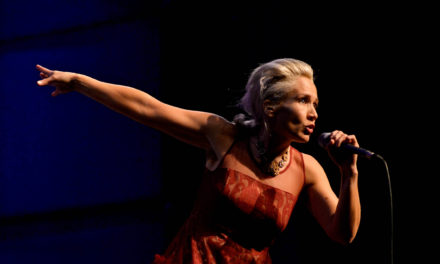By Kelly Oristano
You should not gather your bags and stand to leave the theater at the first curtain call during The Game’s Afoot by playwright Ken Ludwig, now knocking them dead at The Very Little Theatre. You probably won’t be tempted to, though — it happens just four minutes into the play.
The action opens in a British drawing room, where Sherlock Holmes is wrapping up another mystery, but it wraps up so fast that something must be amiss. Indeed, mere seconds into the play, Holmes and Moriarty and various stock characters have finished their tale and are taking a bow, soaking up the plaudits of a receptive audience. The actor playing Holmes, William Gillette (played here by Michael Walker) begins making a curtain speech, revealing that he’s also written the Holmes play just ended and that it’s about to leave New York to go on tour. And since we’re still less than five minutes into the play, it shouldn’t spoil things terribly to say that as the cast wave and blow us kisses, somewhere in the theater a shot rings out.
We spend the rest of the The Game’s Afoot at Gillette’s palatial Connecticut estate, built off the success of his Sherlock Holmes play, with the 1930s actors who were on stage that fateful night spending Christmas Eve together, out of character. Gillette is determined to solve the “Mystery of the Real Bullet” that has delayed their tour and thrown the cast’s lives into comic disorder.
Gillette has parlayed the 20-year run of his Holmes play into a life of New England leisure where he can pursue his various fanciful interests. He has an impressive historical weapons collection, a secret room behind a sliding wall, invisible inks, secret recording devices, hidden passages — it’s every preteen boy’s dream house. On this December 24th, he’s rounded up the usual suspects: Felix and Madge (Tom Wilson and Heather Hinz) are Gillette’s friends from the lean times before the play’s success, longtime cast members, and also suspects in the intrigue; Simon and Aggie, (Matthew Arscott and Sabrina Gross) are later additions to the cast but still very important to Gillette; and Martha (Carol Massahos) is Gillette’s mother, who’s been living with him in Connecticut for a time.
It’s a convoluted and complex mystery, so there’s a great deal of exposition in Act One, but it’s all very funny and director Chris Pinto accomplishes as much by showing the characters’ relationships and stressors as the script does by having them discuss the same relationships and stressors. A stolen glance, for example, between Aggie and Gillette will have significance moving forward. We’re thoroughly grounded in who all these actors (and one mother) are and what they might be hiding when Gillette’s surprise last dinner guest arrives late in Act One.
For reasons only he comprehends, Gillette has invited renowned theater critic Daria Chase (Erica Towe,) to the assembly. The other actors are simply aghast at this plan; after all, she’s recently compared Felix’s performance to “a side of beef” and used national column inches to mock Simon’s shortcomings in the swimsuit area.
But Daria has a special hidden talent that Gillette needs if he’s to solve The Mystery. As she is attempting to do her bit to find the guilty consciences in the room, lights flicker and go black, screams are screamed, and when the lights come up Daria is flailing about the stage in comical agony trying and failing to find anyone who can help her undo her, well, her murder. The opening night audience found this murderous turn wickedly uproarious. As a member of the theater critic profession, I think I must recuse myself from having an opinion on it.
Regardless, we end Act One with a theater critic presumed dead on the floor and an actor in crisis. And that’s exactly where we start Act Two. It wouldn’t serve to delve much deeper into the plot here except to say that the last character, Detective Inspector Goring, (Jen Ferro) appears at just the right moment and does what detective inspectors do in comedy mysteries, and it’s all very good and funny straight through to the end. Director Pinto keeps the beats moving and allows this naturally funny script and his wonderful cast to take full flight through the story without ever flying off the handle into pointless, manic slapstick.
The cast is fantastic from top to bottom with no exceptions; in fact there is no bottom, it’s a thoroughly egalitarian ensemble. Walker is by default charming and rather amused as Gillette; the few moments when charm and amusement go away play powerfully. Wilson and Hinz could’ve been playing these roles together for ages, they’re comfortable together as a couple and a delight to those around them. Wilson is also a wonderful skeptical foil for Gillette’s enthusiasm. Arscott and Gross have multiple sides to their characters. We start to suspect it upon learning they knew each other previously in a town called Killington, Vermont. But only toward the end do we realize that they’ve been playing a dangerous game, and playing it quite well. Carol Massahos is very funny as Gillette’s long-serving, long-suffering mother.
Ferro and Towe in the (slightly) smaller roles are a couple of godsends. Towe enters with huge energy and draws the whole transition from Act One to Act Two around Daria with devilish delight. Even after she’s presumed dead in Act Two, she still gets a dozen or so huge laughs. Ferro’s Inspector Goring provides the fuel to keep Act Two moving like it wants to. She’s broad, dense, suspicious, and credulous at all the wrong times, and supremely funny at every turn.
The production also showcases lovely design work all around. Michael Watkins’ costumes are pleasingly colorful, highly functional, and era-appropriate, a tough triad to achieve. Michael Walker designed and built the set, which is big and spacious and fun, and it serves the story well. Even the sound design was notable in moving the plot forward. Strains of Beethoven cover scene changes, piped-in audience reactions let us know when we’re watching a play-within-a-play, a News Of The World-style voiceover gives a big smash of early exposition. These and other touches from Pinto and sound designer Chris McVay and lighting designer Gail Rapp create a fully realized little world we can understand, and where we can happily spend a few hours.
It doesn’t slow down to let you think too much, but at one point, when Gillette is accused of thinking these matters of life and death are “a joke,” he makes a point of saying that they’re not a joke at all, but a game. He goes into some depth on the difference between the two, and opines that a life well lived is lived in the knowledge that it is a game all along. That’s light philosophical fare, but it’s fully in keeping with what this play wants to be. It’s got jokes by the barrelful, but the play itself is a game — a game that this cast obviously have won.
The Game’s Afoot continues at The VLT
When: Evenings at 7:30 p.m. on June 13-15, and 20-22; matinee at 2 p.m. on June 16; the opening night show is followed by a post-show gala with refreshments
Where: The Very Little Theatre, 2350 Hilyard St., Eugene
Tickets: $21; $17 for senior citizens and students and all Thursday performances, available at the box office, 541-344-7751, from 1:30 p.m. to 5:30 p.m. Wednesday through Saturday, or online at TheVLT.com; listening devices available for the hearing impaired on a first-come basis
(Correction: Chris McVay is the sound designer for this production, and Gail Rapp is the lighting designer; an earlier version misidentified McVay and omitted Gail Rapp.)










Hey Kelly, thanks for the nice review.
Just want to offer a correction…….Chris McVay is the sound designer for Game’s Afoot. Gail Rapp is the light operator.
Thanks, Nancy. The correction has been made in the text of the story.